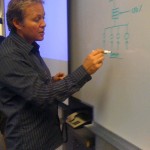VISUALIZATION AND SITUATIONAL AWARENESS – PART I OF II: THE BASICS
/Team situational awareness has been a common topic in this blog, but tonight I’d like to expand beyond the team. Team situational awareness has been a common topic in this blog, but tonight I’d like to expand beyond the team. Monday, Craig Meek, founder and CEO of iVistra gave a great talk at Santa Clara University’s Leavey School of Business (Thanks go to Mary Furlong for inviting Craig to speak with us). His topic was data visualization and entrepreneurship. Certainly those are important topics, but what got me in the room was his connection to the America’s Cup. iVistra provided the online real-time 3D graphics and tracking for the 32nd Cup. Sailing may have been the hook, but once I saw the capability he was providing to his clients, I quickly started thinking about how data visualization relates to situational awareness.
Team situational awareness has been a common topic in this blog, but tonight I’d like to expand beyond the team. Monday, Craig Meek, founder and CEO of iVistra gave a great talk at Santa Clara University’s Leavey School of Business (Thanks go to Mary Furlong for inviting Craig to speak with us). His topic was data visualization and entrepreneurship. Certainly those are important topics, but what got me in the room was his connection to the America’s Cup. iVistra provided the online real-time 3D graphics and tracking for the 32nd Cup. Sailing may have been the hook, but once I saw the capability he was providing to his clients, I quickly started thinking about how data visualization relates to situational awareness.
The basics as I see them:
Teams have trait and state characteristics. Traits include fundamentals like transactive memory (knowing who knows what, and how to coordinate as a result) and absorptive capacity (knowing how to effectively recognize and bring new information into the team). These are critical to the team’s DNA, and while they develop over time, they are relatively stable. States include real time status indications. In my last team situational awareness post I used the tennis ballkids’ signaling with their hands as an example of their showing the state of whether or not they had any balls available.
Data visualization has two parts: The underlying conceptual model which causes certain data to be collected and then the conceptual model which results in the presentation of particular relationships. Think of this as choices around what kinds of sensors to install in your car (speed, engine temperature, but not how much the driver’s seat is reclined) and then how to present that information (analog versus digital; in the dash, or in a heads-up display).
I’ve been writing about team situational awareness as this state information is important to effective teamwork, and has varying challenges for teams that are collocated versus virtual. iVistra’s tools highlight the value of situational awareness for broader organizational systems. Their custom designed systems (software, sensors, communication links) provide organizations with the ability to track and understand complex systems like supply chains, trucking systems (speed, driver drive times, maintenance schedules), trains (position, operational and financial information), and assets (e.g., portable generators, their charge levels, and locations such that problems can be solved most efficiently). Yes, these systems exist – think of NASA’s Houston Mission Control Center, or WalMart’s renowned inventory tracking and control systems (using a set of computer systems described by CNBC as second only to the United States Pentagon’s, CNBC "The Age of Walmart", 2004).
What’s new is that these systems aren’t requiring computer systems rivaling NASA or the Pentagon’s. They are available to the rest of us. The trick is how to know the states that matter, and how to relate them in important ways, given the traits of the team or organization. This is evidence-based management in real time.
I asked Craig how his clients come to integrate their new knowledge with new organizational practices that can extract the most value. He suggests that it’s an evolution. iVistra provides business analysts that work with the company to develop requirements based on their experience in the field. The system is designed and implemented to those requirements, and then it is an on-going process to tune organizational activities and opportunities for new streams of data.
I expect the organizations that understand this as process – rather than as a technology purchase – will be gaining the greatest benefit. I know that the America’s Cup teams work very hard to collect baseline data, test new techniques and equipment, and then use the results of these experiments to fine-tune their campaigns. This is a formalized, but very innovation focused, approach.
Part II will look at the form of visualization.







